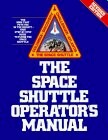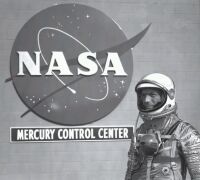NASA Shuttle Home - Press Releases
NASA Space Shuttle Reference Manual is still available as a 306-page .pdf. Space Shuttle Orbiter ReferencesOrbiter cutaway diagram, a 2253x1033 .jpgShuttle Payload Bay User's Guide 255 page .pdf Space Shuttle External Tank ReferencesNASA-MSFC Shuttle ET illustrations include a large External Tank cutaway diagram, a 5530x2060 .jpgNASA Shuttle Mission Information has concise but complete descriptions of each of the Space Shuttle missions, from STS-1, launched on April 12, 1981, to STS-135. KSC NASA Space Shuttle Launch Archives covers STS-1 to STS-135 The NASA History Office has countless pages of history information and images to view, accessible from this subject listing page, or keyword searchable. NASA History: The Flight of STS-1 Orbiter Fleet Space.com Return to Flight news archive scitech.quickfound.net's NASA Subdomains Search & Links page links to dozens of the numerous NASA subdomains, and includes two search engines, NASA advanced search and a customized version of Google, both of which you can use to search the NASA subdomains independently by copying the subdomain name (using ctrl-c) and pasting it (using ctrl-v) into the appropriate place on the forms (which are at the bottom of the page).
|
NASA paid Russia's Federal Space Agency $719 million to carry 15 crew members to and from the ISS between 2009 and 2011. Additional arrangements were made for Soyuz spacecraft to provide transport to and from the ISS until an American crew vehicle is available. NASA Commercial Crew & Cargo program, including Commercial Orbital Transportation Services (COTS). Commercial Crew Spacecraft Requiremnets NASA's Old Plans: Multi-Program Integrated Milestones MPIM October 19, 2007 - MPIM February 3, 2009 NASA News | ||||||||||||||||||||||||||||
| Orbiter is a freeware Space Shuttle (and other spacecraft) flight simulator. Launch the Shuttle to deploy a satellite or rendezvous with the ISS. "The emphasis is firmly on realism, and the learning curve can be steep." Free plugins allow Orbiter to simulate Mercury & Gemini missions & more. Orbiter is totally free, though author Martin Schweiger will accept donations. screenshots |
In the Spring and Summer of 2003, the cause of the breach in the leading edge of the Space Shuttle Columbia's wing on the STS-107 mission was attributed to the impact of foam insulation from the shuttle's external tank on the wing. On the basis of video that showed a chunk of insulation apparently impacting the wing, plus calculations indicating that ET insulation could have been the cause of the hole in the leading edge of the wing, the board flatly declared that ET insulation was the cause of the Columbia breakup.
The CAIB's conclusions led to redesign of the Space Shuttle External Tank, to avoid foam insulation breaking off during flight. The redesign and its implementation took almost 2 years. |
|
(Jul 17, 2006) Space Shuttle Discovery landed at the Kennedy Space Center in Florida on Monday, July 17, at 9:14 AM EDT, ending the STS-121 mission. Discovery was launched on Tuesday, July 4 at 2:38 PM EDT, and flew to the International Space Station, where the crew tested new equipment and procedures to increase the safety of space shuttles. They also delivered supplies & cargo to the ISS, and performed maintenance on the station. The mission is being considered as a complete success, with "minimal" loss of foam insulation from the external tank during launch. Loss of foam coating the ET was blamed for the STS-107 Columbia breakup in 2003. "Normal" shuttle operations are now expected to resume--but the 3 shuttles are still scheduled to be retired by 2010. STS-121 press kit, 6MB .pdf - Return to Flight (Oct 16, 2005 revised Dec 2 & Dec 11) NASA has released a "Tiger Team" report on preventing External Tank (ET) foam loss, and the next Space Shuttle mission, STS-121, is now targeted for a launch window between May 3 and May 23, 2006, with the following mission in July. On the last shuttle flight (STS-114), foam insulation broke off the 37-foot "PAL" ramp, which runs along the side of the ET to smooth airflow around pipes and cables. NASA plans to remove the ramp, and either eliminate it altogether, or replace it with a new type of foam, applied to minimize shedding. Part of the ramp was replaced by foam before the STS-114 mission, and that area of foam did not shed. The STS-121 ET has been brought by barge back to the New Orleans factory to be prepared for the STS-121 mission. Florida Today story NASA is also investigating a possible gaseous oxygen link in Discovery's engine compartment during the STS-114 launch. This issue must be resolved before the next Shuttle flight can occur. Tiger Team fact sheet, 81KB .pdf - full report, 2.1MB .pdf (Aug 18, 2005) The next Space Shuttle flight, STS-121, which was to be of the orbiter Atlantis in September, 2005, is now targeted for March, 2006, and the orbiter Discovery will fly the mission instead of Atlantis. Two "Tiger Teams" are investigating fixes for the External Tank foam loss during Discovery's launch on July 26, and NASA says "the teams... are making good progress..." press conference transcript, .pdf (Aug 9, 2005) The Space Shuttle Discovery landed at Edwards Air Force Base in California on Tuesday at 5:11am PDT after 14 days in orbit. photo (Aug 5, 2005) NASA STS-114 mission managers have decided that a 4th spacewalk to remove a "ruffled" thermal blanket will not be needed. The TPS blanket is located below the commander's window of the Space Shuttle Discovery. The concern was about debris striking the rest of the vehicle should the blanket come loose, not about direct overheating. AP story (Aug 3, 2005) On Wednesday morning, in the 3rd and final EVA of the Space Shuttle Discovery's STS-114 mission, Mission Specialist Steve Robinson rode on the tip of the Station's robotic arm to the Shuttle's underside and located two Thermal Protection System gap fillers that were protruding from areas between heat-shielding tiles. Robinson then gently tugged the gap fillers until they came out. The ceramic coated-fabric gap fillers are used to protect against hot gas from seeping into gaps between the Shuttle's protective tiles, and were considered a potential threat to a safe reentry. NASA feature: gap filler removal - All STS-114 Videos (July 28, 2005) Photo analysis of the External Tank from Tuesday's launch of the Space Shuttle Discovery has shown that a large piece of spray-on foam insulation again broke off the ET during ascent, although there is no indication that it damaged or even struck the orbiter vehicle. ET photos showing missing foam The piece of foam missing from the ET is about 24"-33" long, 10"-13" wide, and 2½"-8" thick. probably weighing less than a pound. A similar, somewhat larger, piece of falling insulation has been blamed for putting a hole in a RCC (reinforced carbon-carbon) cap on the leading edge of the shuttle Columbia's wing in 2003, leading to the destruction of that vehicle and the loss of seven lives on reentry. (July 26, 2005) The Space Shuttle Discovery was successfully launched on Tuesday, July 26, at 10:39am, and reached orbit without any difficulties. Shuttle engineers think that a grounding problem might have caused the incorrect sensor readings that scrubbed last week's launch attempt. No problems with the previously problematic fuel sensor system were encountered in any of three tests run during the countdown, or during the launch itself. Discovery is making the first Space Shuttle flight since the STS-107 Columbia breakup in early 2003. This is the 114th shuttle flight in all, and the 31st flight of the Discovery. The mission, STS-114, has a crew of 7 commanded by Eileen Collins (the only female shuttle commander). They are carrying much-needed supplies (in the Rafaello Multi-Purpose Logistics Module) to the International Space Station. In addition, two astronauts will make 3 EVAs. The planned launch of the Discovery on mission STS-114 from Pad 39B at the Kennedy Space Center was "scrubbed" at 1:32pm EDT on July 13, due to a false reading from a low fuel level cutoff sensor in the Shuttle's External Tank. The sensor is one of four LH2 low level sensors in the ET. The sensors are only used during flight, to trigger a shutdown of the engines if fuel is running out. Running the Shuttle main engines without fuel would cause a catastrophic failure. |
NASA Books (NASA Special Publications) & NASA Articles Online
|
Some of the books below are Adobe .pdf files, which are nice for reading materials offline. If you would like to read NASA's .html online books, like most of those below, when you are offline, you can "harvest" the pages and images for free using HTTrack, a very useful freeware website capture and offline browsing tool. HTTrack also works well with groups of .pdf files linked to from a page or directory. Space Shuttle Books Shuttle Crew Operations Manual is a 1161 page, 42 MB .pdf Shuttle Payload Bay User's Guide is a 3.5MB, 255-page .pdf. Shuttle Operational Aerodynamic Data Book 391 page .pdf Orbit Operations Checklist (2008) is a 419-page .pdf of onboard instructions without explanations Space Shuttle Avionics System SP-504 (1989) from STSLiftoff.com Upgrading the Space Shuttle is the full text of a 1999 report from the National Research Council Committee on Space Shuttle Upgrades. Toward a History of the Space Shuttle: An Annotated Bibliography Part 1, to 1992 is a very complete list of categorized and annotated Space Shuttle history text references. A 96 page .pdf. Toward a History of the Space Shuttle: An Annotated Bibliography Part 2, 1992–2011 148 page .pdf. Personal Observations on the Reliability of the Shuttle is the full text of Richard Feynman's addendum to the Challenger Commission report on the catastrophic loss of a Shuttle and seven lives on January 28, 1986. The Space Shuttle Decision: NASA's Search for a Reusable Space Vehicle SP-4221 (1999) Space Shuttle SP-407 (1976) The Space Shuttle At Work SP-432 (1979) Science in Orbit: The Shuttle & Spacelab Experience: 1981-1986 NP-119 (1988) STS-51L Challenger Rogers Commission Report (1986) Columbia Accident Investigation Board Report 400 page .pdf over 100 NASA online books are listed on the NASA News page |

